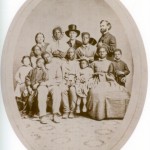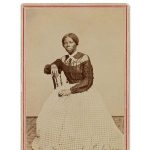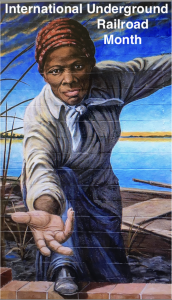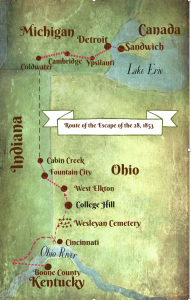Author speaks about her new booklet
July 13, 2019
Our newest publication, John Hatfield Barber, Deacon, Abolitionist, was written for the Hatfield family and researchers. There are two versions available on our current publication page—a version of the story and an expanded version with more genealogical information.
I’m going to interject myself into the story now, something I don’t usually do. I let history speak for itself; I leave interpretation to others. I don’t believe in evaluating the mores of the past through our feelings and political correctness of today. History was and is; it can stand on its own two feet. History has taught me that it does repeat itself and undergoes constant retelling, rewriting and reinvention. Frequently it is distorted, slanted, pieces left out to reshape the narrative.
I started out wanting to know more about John Hatfield the abolitionist. He is sometimes mentioned by Levi Coffin and since I am interested in College Hill history, I wanted to fill him out as a person in my mind. Especially in regards to the “Escape of the 28.” Who were his parents? Why did he hear the call of abolition? What happened to him?
His story has holes I wish I could fill but the written word only goes so far. Most of his life never made it into the newspapers. He left no diaries or stack of letters behind. Not even a picture.
When I started researching John in detail I searched Ancestry.com and there was a family tree that looked like it belonged to him. I sent the writer a query, waited a little, and Susan Hatfield replied …and that is how it all began. Because of our Hamilton Avenue Road to Freedom website, I heard from Marion McDuffie. I contacted Doris Gaspar in Canada as a follow up to an article she wrote that was posted online mentioning John Hatfield in Amhurstburg. The pieces started to come together and the family story just got larger.
From our group Diana and her husband Len traveled to all the towns that the freedom seekers passed through on their escape route. It was in Ann Arbor that they visited the African American Cultural and Historical Museum of Washtenaw Co. and met Deborah Meadows, a member of their Board of Directors. Diane explained our quest and how we wanted to find surnames for the 28 freedom seekers. While Deborah didn’t know these names, substantial history was exchanged. A delightful thing came from this encounter. Charles Campbell, Deborah’s husband, was in film school and decided to make a feature length film about the Escape, “All or Nothin’.” He received his degree and shows the movie around the country. Charles is currently working on a novel, expanding upon the film. Parts of the movie were shot in and around Cincinnati, and Len portrayed Rev. Jonathan Cable.
Our research into the Escape story led us back across the Ohio River into Boone Co. Because of the dedication of Bridget Striker and Hillary Delaney of the Boone Co. Public Library we now know the farms that the enslaved people fled from and some of their names. The Burlington courthouse did not burn during the Civil War and the slave tax receipts are intact. It took many hours and painstaking research on their part to create a data base of hundreds of names they now know. Embracing the past, there is an Underground Railroad bus trip for the county and it is presented by the library.
Hamilton Avenue Road to Freedom is a group of five women who are researching the Underground Railroad as it pertains to our communities. We are part of the College Hill Historical Society. While many college degrees are represented, none are in history, but we embrace historical research and are good at it. We each have a specialty and while we meet and exchange information we are essentially a group of committees of one. Diana is interested in the religious aspects-the Quakers and the “Come-Outer” movement and how it relates to the students that attended Farmers’ College, also the Reconstruction period. Lisa for years has tracked down several black families in Erlanger, Ky., their escapes and relocations. Lisa is a volunteer with the Freedom Center’s library. Kathy is the expert on the Wesleyan Cemetery and all things Cumminsville/Northside. When she worked for the Cincinnati Park Board, Kathy wrote and led a winter trail walk that we know followed the same path taken by some of the freedom seekers through our community. Karen has the community north of College Hill, Mt. Healthy, which was an important Underground Railroad station and had a large black community. Me, I just know College Hill history really well and recognized several decades ago that Hamilton Avenue was a major conduit for the Underground Railroad. I wanted to document oral and written accounts from older residents, property owners and anything else we could locate because information is irretrievably lost when a person dies or a property is sold.
In my country, right now, today, I see that we are taking long regressive strides in race relations. There is a segment that would repeat with gusto the attitudes of 150 years ago. This cannot happen. (Yes, I’m an old hippie). The Underground Railroad is an example of people with strong convictions that worked together interracially. A single person can make a large imprint – John Hatfield and his family is proof of this. History can be a guiding force for the greater good.
The Hatfields, Chandlers and Coles are lights in the darkness. Strong people all. Linking you back together has been one of the most rewarding things I have ever done. Researching your family has been an honor and a privilege.
Betty Ann Smiddy
 Previous Post
Previous Post Next Post
Next Post

